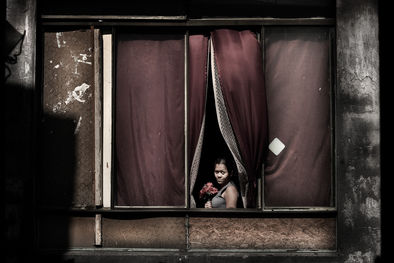FOTOTECA SIRACUSANA
PHOTOGALLERY - FOTOGRAFIA VINTAGE - BIBLIOTECA TEMATICA - CAMERA OSCURA B&W - DIDATTICA
SCRIPTPHOTOGRAPHY
Julio BITTENCOURT (Brasile)

JULIO BITTENCOURT
“Windows”, ma stavolta Microsoft non c’entra nulla. C’entra piuttosto il giovane fotografo brasiliano Julio Bittencourt, che nel 2008 ha pubblicato un apprezzatissimo libro fotografico “In a window of Prestes Maia 911 building”. L’edificio di San Paolo non è solo un grattacielo di ben 22 piani, è la più grande casa occupata che si conosca e ai cui residenti abusivi viene intimato uno sfratto di massa. Hanno poco meno di un mese per lasciare le loro (fatiscenti) abitazioni. Julio Bittencourt ne racconta il passaggio. Qui non siamo nei dintorni del “vedere senza essere visti”, non c’è nulla di letterario; non c’è traccia di derive voyeuriste né le immagini procurano i turbamenti provenienti dallo spiare la vita altrui. In “In a window of Prestes Maia 911 building” il diaframma delle pruderie è allontanato e siamo invitati a leggervi una dimensione politica che vira verso l’intimità di persone colte negli ultimi giorni della loro permanenza nello stabile.
Poesia degli ultimi giorni, e ognuno recita il proprio verso. E’ inevitabile cogliere negli sguardi degli adulti la preoccupata normalità di un futuro incerto – mitigato dalle espressioni innocenti dei bambini, colpevoli a loro insaputa – ma siamo in Brasile, dove “a tristeza não tem fin”, cantavano Jobim e De Moraes, ma ci si balla su quelle note, e dunque nulla è davvero così drammatico. Ecco allora uomini e donne colti in gesti affettuosi a favore di obiettivo; futuri giovani esplorare l’esperienza della genitorialità; donne aver cura dei fiori al balcone e altri gesti che hanno l’obiettivo, seppur momentaneo, di scacciare il destino prossimo venturo facendosene beffe. Un antidoto, perché solo “la tolleranza” fa dire Shakespeare a Otello “può riuscire a mutare quel torto solo prendendosene beffa”. C’è dunque un respiro di normalità nelle immagini delle finestre, un afflato vitale che Bittencourt ci restituisce in forma documentale in cui il lavoro del fotografo è quasi ingabbiato nella rigidità del suo obiettivo. Se notate la macchina fotografica è fissa. Sempre. E’ sempre posta alla stessa distanza, le dimensioni dei soggetti sono sempre gli stessi, come se nel disagio comune il fotografo avesse letto una “democrazia della disgrazia” nella quale si è tutti uguali, mandando a dirci che a queste latitudini l’assioma secondo cui “tutte le famiglie felici si assomigliano fra loro, ogni famiglia infelice è infelice a suo modo” (Tolstoj), proprio non funziona.
Giuseppe Cicozzetti
da “In a window of Prestes Maia 911 building”
foto Julio Bittencourt
"Windows", but this time Microsoft has nothing to do with it. Buti it has much to do young Brazilian photographer Julio Bittencourt, who in 2008 published a much appreciated photobook "In a window of Prestes Maia 911 building".
The building of São Paulo is not only a skyscraper of 22 floors, it is the largest occupied house that is known and whose abusive residents are ordered a mass eviction. They have just under a month to leave their (crumbling) homes.
Julio Bittencourt tells the passage. Here we aren’t in the neighborhood of "seeing without being seen", there’s nothing literary; there’s no trace of voyeuristic drifts, nor do images give rise to disturbances from spying on the lives of others. In "In a window of Prestes Maia 911 building" the diaphragm of the prudery is turned away and we are invited to read a political dimension that turns towards the intimacy of people gathered in the last days of their stay in the building.
Poetry of the last days, and each one recites his own verse. It’s inevitable to grasp in the eyes of adults the worried normality of an uncertain future - mitigated by the innocent expressions of children, guilty without their knowledge - but we are in Brazil, where “tristeza não tem fin", sang Jobim and De Moraes, but they dance on those notes, and therefore nothing is really so dramatic.
Here then men and women caught in affectionate gestures in favor of the goal; future young people explore the experience of parenting; women taking care of the flowers on the balcony and other gestures that have the objective, albeit momentary, to drive away the next fate by making fun of it. An antidote, because only "tolerance" makes Shakespeare say to Othello "can be able to change that wrong only by taking mockery".
There is therefore a breath of normality in the images of the windows, a vital inspiration that Bittencourt returns to us in a documentary form in which the photographer's work is almost caged in the rigidity of his lens. If you notice the camera is fixed. Always.
It is always placed at the same distance, the dimensions of the subjects are always the same, as if in the common discomfort the photographer had read a "democracy of misfortune" in which we are all the same, sending to tell us that in these latitudes the second axiom where "all happy families resemble each other, every unhappy family is unhappy in its own way" (Tolstoy), it just does not work.
Giuseppe Cicozzetti
from “In a window of Prestes Maia 911 building”
ph. Julio Bittencourt








